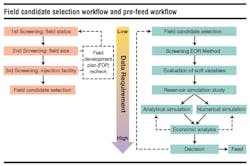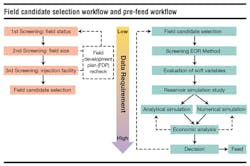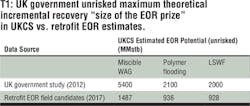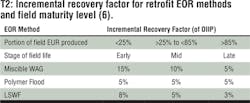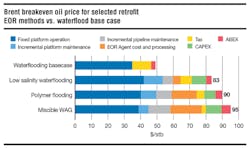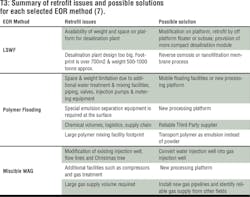Technical, economic constraints hinder widespread UK offshore EOR retrofits
More incentives needed, study suggests
Bob Harrison
Lloyd’s Register
Chandra Fadhillah
Amiin Pertamina
Gioia Falcone
University of Glasgow
Enhanced oil recovery (EOR) can extend the producing lives of mature fields by delaying abandonment and maximizing economic recovery, which is a strategic goal of the UK government for fields on the UK continental shelf (UKCS). However, there is a limited window of opportunity, as the region’s offshore infrastructure is ageing and with decommissioning looming, some production hubs may become unavailable for future retrofit EOR projects. The ‘size of the prize’ is the primary consideration of any offshore operator of a mature field, who would implement a retrofit EOR scheme only if it were more profitable than continuing with existing waterfloods.
This article assesses the EOR potential of mature fields undergoing waterflood in the main oil producing regions of the UKCS, based on a review of three ‘retrofit’ EOR methods: low salinity waterflooding (LSWF), polymer flooding, and miscible water alternating gas injection (WAG), all of which can be implemented by modifying existing facilities and well stock. After screening the technically recoverable volumes, the assessment employs a pre-front-end engineering design (pre-FEED) workflow that considers operational constraints, refinement of recovery estimation with reservoir modeling, and incremental economic analysis.
Field selection criteria
Waterflooding is the prime development option on the UKCS, so retrofit EOR schemes must suit the available infrastructure. Barriers to EOR implementation include incomplete understanding of the subsurface; a limited supply of reliable and cheap EOR agents; limitations on space and weight for retrofitting of EOR modules on brownfield facilities; and uncertainty over the impact on project economics. However, Sir Ian Wood’s 2014 Review (2) of the UK’s remaining potential warned that insufficient uptake of EOR would have a negative effect on maximizing economic recovery, adding that while such schemes are costly and complex to operate, the industry should be encouraged to invest in EOR to avoid leaving significant value behind.
In 2016, the UK government proposed an EOR strategy for existing sanctioned projects (4) and announced new fiscal schemes to stimulate investment in EOR (3). To better understand what is required for EOR investment in the region, the authors employed two EOR decision-making workflows sequentially to go from field candidate screening to the pre-FEED decision.
They also created a comprehensive database of 168 mature fields in the main oil-producing UKCS regions. This data set did not include the five already sanctioned EOR projects. The oil field selection workflow firstly rejected candidates that had ceased production or were classed as high-pressure and high-temperature (HP/HT), leaving 136 oil fields for consideration. The second filter, eliminating fields with best estimates of remaining recoverable oil less than 15 MMbbl, left only 46 potential candidates remaining. The final filter rejected fields without water injection facilities, as existing hardware could be used for retrofit EOR operation, reducing the required capex. The survey also verified the continued availability of petroleum export routes for fields with subsea tieback systems. If the host facility was at risk of ceasing production before the candidate (satellite tie-in) field, then retrofit EOR might not be possible (5).
On completing the selection workflow, just 25 oil fields remained. The authors compared the potential incremental oil recovery from the retrofit EOR field candidates with the UK government’s estimates for the three EOR methods, concluding that the ‘size of the EOR prize’ was less than half that of the UK government’s 2012 target of 600-1,200 MMboe, from more than 100 oil fields on the UKCS.
The review then progressed to the more rigorous pre-FEED workflow to determine whether the retrofit EOR schemes would be technically possible and commercially viable. Initially, this involved comparing the compatibility of the proposed EOR method with the key reservoir parameters of the candidate fields, with the most suitable EOR scheme then assigned to each field. The potential recovery factor for each EOR method was based on a percentage of original oil in place (OOIP). Field maturity level was incorporated to account for the time effect on EOR incremental oil recovery, as EOR processes are more efficient if implemented earlier in an oil field’s life (16). The OIIP data were gathered from published sources; where no data were available, OIIP was estimated from estimated ultimate recovery (EUR) divided by the average North Sea oil recovery factor of 46%.
The next step was to assess the impact of soft variables on retrofit EOR projects, such as the feasibility of performing the necessary modifications to the existing facilities and whether EOR agents could be imported. Availability and proximity of potential gas sources for miscible WAG candidate fields were qualitatively checked using field locations and pipeline network maps. Fields without likely gas supply sources were removed from the list of WAG candidates and reassigned to the list of LSWF or polymer flooding candidates. The amount of EOR agent required was estimated from average values (6) for miscible WAG, where 10 MMcf of solvent must be injected for each barrel of oil produced; the efficiency of polymer ranges from 0.3 to 0.5 pounds per barrel of oil produced.
Reservoir simulation is needed to predict the ultimate oil recovery for each retrofit EOR method. As full field numerical simulation models are usually proprietary to operators, simple material balance tank models and 1D layered analytical models, which require far less data, can be used to mimic the operator’s numerical simulation, delivering reasonable predictions (8). As an example, a baseline material balance model, matched to the production history, gives a water fractional flow curve to generate the corresponding field relative permeability curves required for forecasting.
This baseline model can predict WAG performance by setting the gas injection schedule to a three and a half-month cycle as the normal operating condition (9). It can also simulate LSWF behavior by changing relative permeability end points to mimic wettability alteration in the reservoir. The polymer flooding case is simulated in a 1D model by increasing the viscosity of the injected fluid (10). The simpler modeling approach gives an overall recovery from retrofit EOR of around 65% of OOIP. From a recovery perspective, miscible WAG has the highest potential and is predominant in each UKCS region. There are more candidates for LSWF than polymer flooding, but the recovery estimates for both these latter methods are similar.
Things are less clear from a retrofitting perspective, as miscible WAG schemes face major challenges related to installing new pipelines to securing reliable gas supplies for a long period. The UK regulator the Oil & Gas Authority has stated that there is a limited amount of hydrocarbon gas supply available in the UK’s producing oil fields, so regional and current market conditions may reduce the likelihood of miscible WAG projects being developed. LSWF and polymer flooding are more likely to be implemented as they use seawater which is clearly readily available offshore. However, retrofitting a large desalination module to a platform is not straightforward, and polymer flooding brings its own challenges such as the need to purchase polymer chemicals and associated logistics throughout the project life. Weight and space limitation are the biggest challenges in retrofitting EOR methods to existing facilities.
The final step of the pre-FEED workflow involved performing an economic evaluation using the incremental oil production profiles from simulation. The present waterflood scenario is taken as the base case for the discounted cash flow analysis, which is then compared to the economic assessments of the retrofit EOR methods. Post-tax net present values at 10% discount rate for all cases revealed that none of the retrofit EOR schemes were commercial compared to the waterflood base case, although the forecast incremental oil recovery was higher in all EOR cases. The economic model also predicted that EOR implementation could delay abandonment of a North Sea waterflood by up to four years.
A breakeven oil price analysis using unit cost per stock tank barrel shows that LSWF is the cheapest retrofit EOR method. For 2017 economic conditions, retrofit EOR projects require a breakeven Brent Crude oil price of $83-95/bbl. The highest contribution to unit cost per barrel arises from higher fixed platform and EOR operating costs. For the miscible WAG case, the higher capital and operational expenditures relate to installation of a new gas pipeline and the purchasing and processing of the gas. The highest incremental platform maintenance is incurred with LSWF, which requires significant facilities modifications to accommodate a desalination module, but LSWF has the lowest EOR agent processing costs of the three methods. Polymer flooding has higher incremental operational costs arising from purchasing polymer chemicals and more demanding supply chain management.
The initial field candidate screening workflow showed that significant technical recoverable volumes of oil are feasible through implementation of retrofit EOR schemes on the UKCS. However, the subsequent more rigorous pre-FEED workflow revealed the scale of the operational and economic challenges in the region. For retrofit EOR schemes to be implemented in the sector, there needs to be a sustainable increase in the oil price; the UK government needs to introduce more incentives such as targeted tax breaks for EOR incremental cash flows; and offshore operators must continue their recent success in lowering operating costs and improving and maintaining operational efficiencies. •
The authors
Bob Harrison devised the EOR review following an invitation by Dr. Gioia Falcone, visiting professor at Imperial College London on Production Engineering, to supervise students engaged in suitable MSC projects. His idea for this program was influenced by David Hughes, a former LR EOR specialist who has expressed concerns that EOR reviews were virtually all screening studies that rarely carried through to the pre-FEED stage, not looking at operational and commercial issues or putting an economic value on such projects. Harrison operates his own UKCS reservoir and field database that he updates with field data provided by the OGA and industry analysts. The LR Facilities/Costing group also supported the team in devising the three retrofit technical/economic scenarios.
References
• PILOT (2014) Report summarizing 2012-3 activities. PILOT EOR Workgroup. Dept. of Energy & Climate Change, UK
• Wood, I. (2014) UKCS: Maximising recovery review. Report for Dept. of Energy & Climate Change, London
• Conway, K. (2016) UK Budget 2016: Oil and Gas Taxation. King & Spalding,https://www.kslaw.com/blog-posts/uk-budget-2016-oil-and-gas-taxation-2 (accessed 10 August 2017).
• Alvarado, V. and Manrique, E. (2010) Enhanced oil recovery: field planning and development strategies: United Kingdom. Gulf Professional Publishing.
• Willigers, B.J.A., Prendergast, K. and Muslumov, Z. (2010) North Sea dominos: the economic dependencies of infrastructure assets and their user-fields. Presented at the SPE Hydrocarbon Economics and Evaluation Symposium, Dallas, Texas. SPE-130156-MS
• Lake, L. (1989) Enhanced oil recovery: Englewood Cliffs, N.J., Prentice Hall.
• Amiin, C. (2017) North Sea oil field EOR candidates: screening to FEED authorization. Report submitted in partial fulfilment of requirements for MSc/DIC, Imperial College London.
• Manrique, E. and Wright, J. (2005) Identifying technical and economic EOR potential under conditions of limited information and time constraints. Presented at the SPE Hydrocarbon Economics and Evaluation Symposium, Dallas, Texas. SPE-94682-MS
• Awan, A.R., Teigland, R. and Kleppe, J. (2008) A survey of North Sea EOR projects initiated during the years 1975 to 2005. SPE-99546-PA. SPE Reservoir Evaluation & Engineering 11 (03): 497-512.
• Pope, G. (1980) The application of fractional flow theory to enhanced oil recovery. Society of Petroleum Engineers Journal 20 (03): 191-205.
